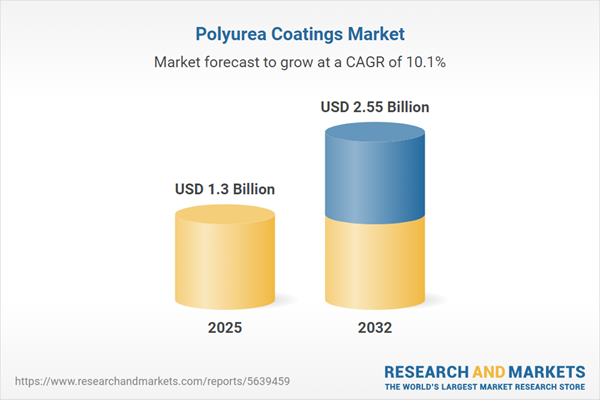Speak directly to the analyst to clarify any post sales queries you may have.
Leaders in asset-intensive industries are prioritizing innovative protective solutions to address increasing regulatory pressures and demanding operational environments. The polyurea coatings market is seeing sustained executive interest as organizations seek reliable ways to lengthen asset lifespans, maintain compliance, and streamline critical processes.
Market Snapshot: Polyurea Coatings Market Growth
The global polyurea coatings market is advancing steadily, with heightened traction among industries requiring rapid-application, high-performance protective systems. Industry analysts project market expansion from USD 1.18 billion in 2024 to USD 1.30 billion by 2025 and USD 2.55 billion by 2032.
Demand is driven by the need to optimize asset value, support ongoing operational improvements, and uphold stringent compliance requirements. Adoption in commercial real estate, manufacturing, and logistics is rising, as these sectors look to extend equipment life, manage essential maintenance more efficiently, and address complex international regulations. Suppliers continue to develop specialized polyurea solutions tailored for specific sector challenges, enhancing project performance and outcomes across global businesses.Scope & Segmentation: Comprehensive Polyurea Coatings Market Coverage
- Product Types: Polyaspartic, polyurea hybrid, and pure polyurea products are formulated for rapid curing, enabling timely structural upgrades, infrastructure reinforcement, and challenging refurbishment projects. Their fast-setting nature supports operational continuity by reducing downtime and contributing to better capital allocation.
- Applications: Industrial and commercial flooring, heavy-traffic work areas, and protective linings for storage tanks and containers are key application areas. Polyurea coatings safeguard against equipment degradation, leakage, and contamination, while helping organizations align with tightening safety and environmental standards.
- End Use Industries: The core end-user landscape includes automotive, transportation, construction, marine, oil and gas, offshore operations, and a range of industrial sectors. Companies choose polyurea for its resistance to harsh chemicals and extreme mechanical exposures, essential for mission-critical environments.
- Formulations: Offering 100% solids, solvent-based, and waterborne options, polyurea formulations accommodate a spectrum of sustainability and regulatory objectives. These alternatives enable organizations to advance ESG strategies and ensure practical, efficient system deployment.
- Geographical Reach: The market demonstrates strong presence across the Americas, Europe, Middle East, Africa, and Asia-Pacific, including China, India, Japan, Australia, South Korea, Indonesia, and Singapore. Regional procurement norms, compliance mandates, and integration with local project needs shape successful adoption and deployment.
- Competitive Insights: Key suppliers such as Huntsman Corporation, Dow Inc., BASF SE, PPG Industries, The Sherwin-Williams Company, Axalta Coating Systems, Akzo Nobel, Sika AG, RPM International, and Covestro AG focus on product innovation, advanced manufacturing, and comprehensive service networks to address specific customer requirements.
Key Takeaways for Decision-Makers
- Polyurea coatings extend the durability of industrial infrastructure and assets, reinforcing operational reliability in challenging service conditions.
- Transitioning to low-VOC and waterborne polyurea options enables organizations to deliver on sustainability commitments and remain ahead of tightening environmental regulations.
- Digital technologies streamline coating applications, support uniform quality standards, and simplify compliance oversight across geographically dispersed assets.
- Regional policy changes and procurement variances require flexible implementation approaches for consistent results in multi-market projects.
- Strengthening research initiatives and optimizing supply chains positions suppliers and buyers to respond more rapidly to evolving industry demands and regulatory updates.
Tariff Impact: Navigating US Policy Shifts
Recent US tariff regulation changes have prompted market participants to reassess their polyurea coatings supply chain and sourcing strategies. Diversifying production capabilities, fortifying supplier relationships, and proactively managing compliance issues are effective ways to reduce cost volatility and mitigate potential logistical disruptions tied to new regulatory requirements.
Methodology & Data Sources
Market analysis is built on primary interviews with senior executives, thorough technical evaluations, and active collaboration with established industry associations. All insights are validated through respected independent sources to ensure vertical-specific procurement and operational recommendations are actionable and reliable.
Why This Report Matters
- Provides targeted procurement and technology guidance that reflects the latest regulatory requirements and evolving market conditions, supporting high-level decision-making.
- Delivers practical segmentation and insight by application and region, helping organizations identify and act on growth and adaptation opportunities.
- Unifies regulatory, technology, and market perspectives to assist organizations pursuing sustainable market positioning in complex operating environments.
Conclusion
Applying polyurea coatings enhances asset reliability and supports advanced sustainability and compliance goals. Decision-makers benefit from actionable, validated insights that enable them to fully leverage innovative protective solutions.
Additional Product Information:
- Purchase of this report includes 1 year online access with quarterly updates.
- This report can be updated on request. Please contact our Customer Experience team using the Ask a Question widget on our website.
Table of Contents
3. Executive Summary
4. Market Overview
7. Cumulative Impact of Artificial Intelligence 2025
Companies Mentioned
The companies profiled in this Polyurea Coatings market report include:- Huntsman Corporation
- Dow Inc.
- BASF SE
- PPG Industries, Inc.
- The Sherwin-Williams Company
- Axalta Coating Systems, LLC
- Akzo Nobel N.V.
- Sika AG
- RPM International Inc.
- Covestro AG
Table Information
| Report Attribute | Details |
|---|---|
| No. of Pages | 186 |
| Published | October 2025 |
| Forecast Period | 2025 - 2032 |
| Estimated Market Value ( USD | $ 1.3 Billion |
| Forecasted Market Value ( USD | $ 2.55 Billion |
| Compound Annual Growth Rate | 10.0% |
| Regions Covered | Global |
| No. of Companies Mentioned | 11 |









